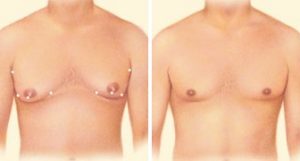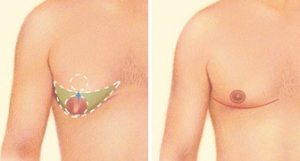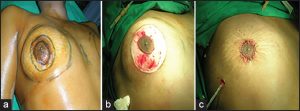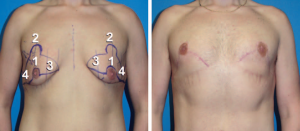Gynecomastia Correction, Male Breast Tissue Removal

Dear Patient,
In this leaflet I aim to explain gynaecomastia and its management in a simple understandable manner.
Gynaecomastia means the enlargement of the normally occurring male breast tissue to such an extent that it may resemble the female breast.
Gynecomastia is far more common than you may think. 65% of boys develop transient breast tissue during puberty and 40% of males over the age of 65 years have some degree of gynaecomastia. Both breasts are usually affected although they may not be the same size.
The condition may have a serious psychological effect on the individual as they fear being ridiculed by their peers and self-conscious about their physical appearance.
The cause of gynaecomastia is an alteration in the testosterone: oestrogen ratio. The excess oestrogen results in a female fat distribution which leads to the development of breast tissue. In 25% of cases there may be no known cause for the development of breast tissue.
Common causes include but is not limited to the following:
It may be a normal or physiological process as would be seen in young babies due to maternal oestrogen, puberty or with increase in age and weight gain.
It may also occur in some patients due to gym supplements, disease or drug intake:
Drugs: Hormonal preparations, anti-hypertensives, anti-nausea agents, antibiotics, sedatives, anti-cancer agents and recreational drugs.
Diseases: Tumours, metabolic disorders or genetic disorders.
Management
During our consultation I will try to ascertain the cause of the gynaecomastia. It may be evident from the history, physical examination or medications. Simple blood tests may have to be done. An examination and perhaps an ultrasound of the testes may be required. A breast ultrasound is always done and a biopsy of the breast tissue may be needed should it be indicated. In many cases there may be no identifiable cause.
I will grade the gynaecomastia according to severity from where a multi-modality treatment protocol will be derived.
Firstly the causative factors will be treated e.g. Change of medication.
An appropriate weight loss and exercise regimen will be suggested. In order to obtain the best result it is important to maintain a lean body mass index.
Medication such as tamoxifen may be used in selected cases especially if the gynaecomastia is of the mild form and there is a clear hormonal influence.
The vast majority of moderate to severe gynaecomastia would have to be treated surgically. The larger the gynecomastia the larger the scars and the greater amount of skin and breast tissue will have to be remove. For very severe cases of gynecomastia I would recommend 2 or 3 sequential surgical procedures to limit scars and get the best aesthetic result.
Surgery,
A gynecomastia procedure includes the following steps:
Medications are administered for your comfort during the surgical procedures. The procedure will be performed under general anaesthesia. In mild cases I use liposuction only. I may do a small cut below the nipple to remove excess breast tissue. In moderate cases I use liposuction and circular excision of the excess skin and breast tissue. Severe cases may require multiple circular excisions and very severe cases will require large, unsightly scars to obtain a flat chest.
In very large gynaecomastia’s we may have to remove the nipple and graft it separately or we may have to remove the nipple and to do a delayed nipple reconstruction. It is for the possibility of nipple loss and poor scarring that I would recommend serial excisions rather than to do it all at once.
Liposuction Technique,

In cases where gynecomastia is primarily the result of excess fatty tissue, liposuction techniques alone may be used. This requires insertion of a cannula, a thin hollow tube, through several small incisions.
The cannula is moved back and forth in a controlled motion to loosen the excess fat, which is then removed from the body by vacuum suction.
There are various liposuction techniques that may be used; the technique most appropriate in your case will be defined prior to your procedure.


Excision techniques are recommended where glandular breast tissue or excess skin must be removed to correct gynecomastia. Excision also is necessary if the areola will be reduced or the nipple will be repositioned to a more natural male contour. Incision patterns vary depending on the specific conditions and surgical preference.
Complications of liposuction and Surgical Techniques,

Sometimes gynecomastia is treated with both liposuction and excision.



